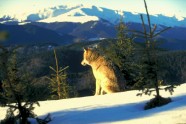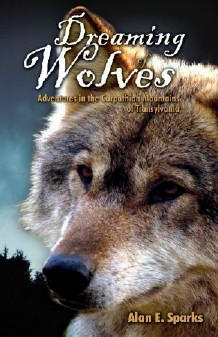The Status of the Wolf - 2. Wolves' Demise
 |
| © B&C Promberger |
Prior to the arrival of European settlers on the shores of North America in the 16th century, wolves could be found throughout the continent. Hundreds of thousands of the canine predator likely ranged the area – hunting, breeding, rearing pups, dispersing and defending territories wherever there was sufficient prey, which was just about everywhere (with the probable exception of some the most arid regions of the southwest). By the mid 1960’s, there were only a few hundred of wolves left in what would become the lower 48 states of the United States, however, surviving within a few hundred square miles of forest in the western Great Lakes region. The saga of the wolf’s demise in the lower 48 (which for the remainder of this article, when the context is clear, I will simply refer to as "the United States") is an illuminating and poignant story of human relations with the wild world, spanning a broad spectrum of human social and psychological dimensions and actions, ranging from ignorance, fear, greed, and persecution to understanding, respect, appreciation, and protection.
Wolves are remarkably adaptive creatures which can survive if not thrive in a diversity of landscapes[1], including relatively close proximity to human settlements as long as there is an ample prey base and limited human persecution[2]. While wolves are opportunistic predators and will if necessary eat animals as small as mice, in the United States the primary natural prey of gray wolves consists of wild ungulates [3]. Depending on where each is (or was) found, these include deer, elk, woodland caribou, bison, moose, mountain sheep, mountain goats, and pronghorn antelope. Red wolves of the Southeast originally preyed mostly on rabbits and rodents, and later, nutria (also known as coypu, a large semi-aquatic rodent which became a pest and threat to natural marshland ecosystems after they were introduced in the early 1900’s from South America); however, reflecting changed ecological conditions, the restored population of red wolves in North Carolina today preys mostly on white tailed deer (50%), raccoons (30%), and rodents and nutria (20%).
Of course domestic livestock are also ungulates, and when the opportunity arises, especially when the availability of wild ungulates is limited, wolves will prey on unprotected livestock such as sheep and cows. They will also sometimes take a dog, be it a pet, a guard dog, or a hunting dog. Although attitudes and actions against wolves in earlier centuries were strongly colored by incredible mythology, it is this threat to domestic animals, together with fears about wolf attacks on humans[4] and the belief that unmanaged wolves will completely wipe out game animals (even though they have never done so) that gets wolves into the most trouble with humans today. While each local region has a theoretical carrying capacity for large carnivores based on environmental conditions and especially on the availability of prey, and while intra-specific behavioral conflicts can also limit their numbers, it is the “social carrying capacity” – the level of acceptance by humans – that is now by far the most important factor determining the size of wolf populations in the United States.
By the 1960’s wolves had been systematically eliminated from most of the contiguous lower 48 States except for a few small populations of hold outs: a few hundred gray wolves in the dense forests of northeastern Minnesota and a few packs on Isle Royale in Lake Superior, a few gray wolves in the arid uplands near the Mexican border, and a few red wolves in the swampy forests of Louisiana and east Texas. Although such factors as loss of habitat to urban and suburban development and the extirpation of bison reduced the viability of wolf populations in some areas, the near complete extirpation of the wolf occurred as a result of direct human intention and intervention. Ignoring potential ecological consequences and perceiving the wolf only as a threat to livestock, wild game populations, and public comfort and safety, the federal government and most states with wolf populations actively sought to eliminate the wolf through predator control programs[5]. Paid professionals utilized whatever means were deemed most efficient, including hunting (both on-ground and aerial), trapping, den destruction/burning, and the use of poison.
To stimulate an even more economical, persistent and pervasive attack, most states with wolves established and maintained bounty systems (beginning with the Massachusetts Bay Colony in 1630), which continued at least until there were no signs of the adaptable predator left. The bounty systems were not always of optimal effectiveness, however, as fraud was common. Some savvy entrepreneurs turned in the ears of dogs, coyotes, foxes, or bobcats instead of those of wolves, and since many bounties applied to pups, some raided dens for the pups but left the mother alive to breed for another year.
The gray wolf was eliminated from the Northeastern US (east of Michigan) by the mid-19th century[6]. In the West, the eradication of one of the wolf’s primary prey animals, the buffalo, led to increased conflicts with the burgeoning livestock industry, and the war against the wolf was passionate and relentless. The last wolf was destroyed in Yellowstone National Park in 1926, in Arkansas in 1928, in Washington State in 1940, and in Colorado and Wyoming in 1943. In the Southwest, Mexican gray wolves (a subspecies of gray wolf that is a bit smaller than their more northerly cousins), which in addition to Mexico originally inhabited Arizona, New Mexico, and Texas, persisted until the 1970’s, but in the end their numbers were unsustainably small. The last five known Mexican wolves were removed from the wild in Mexico in 1980 and put into a captive breeding program. Similarly for the few red wolves that had survived in the Southeast – the last of those were also removed from the wild (where they were in extreme danger of becoming hybridized with coyotes) and placed in a captive breeding program in the same year.
The last refuge for wild wolves in the contiguous US was provided by the remote and dense forests of the northern Midwest. A few reproducing packs hung on in Michigan and Wisconsin as late as about 1960, after which only an occasional lone disperser from Ontario or Minnesota could be found. By the late 1960s, this left the 700 or so wolves that had managed to survive in northeastern Minnesota, along with the few on Isle Royale, as the last reproducing wild wolf populations south of Canada (the exact number reached at the lowest point, which is believed to have occurred sometime in the mid-1960’s is difficult to know – estimates range as low as 300).
— Alan E. Sparks, author of Dreaming of Wolves: Adventures in the Carpathian Mountains of Transylvania
Next – Part 3: Back from the Brink
FOOTNOTES
- Before widespread human persecution greatly reduced their distribution beginning in the 1500’s (when they are believed to have been extirpated in England), wolves were found in nearly every habitat containing ungulates north of central Mexico in North America and north of southern India and Saudi Arabia on the Eurasian continent.
- In addition to the threat posed by people, diseases such as sarcoptic mange and canine parvovirus – the latter likely recently introduced from domestic dogs – can seriously decimate isolated wolf populations, but the effect is usually temporary unless there are other external pressures.
- Wolves will also occasionally eat some vegetative matter to supplement their carnivorous diet.
-
Wolf attacks on humans are extremely rare. It is often claimed that there has never been a documented case
in North America of wolves killing a human, and sometimes this is extended to claim there are no reports of
healthy, (i.e., non-rabid), non-habituated and unprovoked wolves attacking a human. Actually, although
extremely rare, there are a few reports of the latter (see for example
http://www.wolf.org/wolves/learn/basic/wolves_humans/pdf/wh_are_wolves_dangerous.pdf),
and there have been two recent human deaths attributed to wolf attacks: a young man in northern Saskatchewan
in 2005 and a 32 year old woman who was running near the village of Chignik Lake, Alaska in 2010 (there were
no witnesses in either case but investigators believe that wolf attacks were the likely causes).
Interestingly, since they are smaller, usually hunt singly or only in very small packs, and are generally considered less threatening than wolves, in 2009 two coyotes killed a female hiker in a park on Nova Scotia. - Not all states directly joined in the war against the wolf using hired government personnel. Wisconsin, for example, relied on the bounty system to get rid of wolves
- There is some evidence that the original wolf of New England was the red wolf; alternatively, some taxonomists classify the wolf of the region as a subspecies of gray wolf that includes both the “red” wolf and the “eastern” wolf, taking the scientific name of the latter, Canis lupus lycaon; and still others consider this wolf, again including both the red and eastern wolf, to be a species of its own, Canis lycaon. As mentioned in part 1, the taxonomy of the wolf, especially the wolf of eastern North America, is complex and evolving. See Nowak in Wydeven, A.P., Van Deelen, T.R., Heske, E.J, editors (2009).
FURTHER READING
History of human attitudes and persecution of wolves:
Lopez, Barry. 1979. Of Wolves and Men. New York: Charles Scribner’s Sons.
Human attitudes about predators in general:
Quammen, David. 2003. Monster of God: The Man-Eating Predator in the Jungles of History and the Mind. New York: W.W. Norton & Company.
Ecology, behavior, and conservation of wolves:
Mech, L. David and Boitani, Luigi. 2003. Wolves: Behavior, Ecology, and Conservation. Chicago and London: University of Chicago Press.
Wolf recovery in the Midwest:
Wydeven, A.P., Van Deelen, T.R., Heske, E.J, editors. 2009. Recovery of Gray Wolves in the Great Lakes Region of the United States: An Endangered Species Success Story. Springer Science+Business Media, LLC.
The impact of the loss of wolves on ecosystems:
Robins, Jim. 2004. Lessons from the Wolf: Bringing the top predator back to Yellowstone has triggered a cascade of unanticipated changes in the park’s ecosystem. Scientific American Magazine (May).
Wolf restoration (general):
Nie, M. A. 2003. Beyond Wolves: The Politics of Wolf Recovery and Management. Minneapolis: University of Minnesota Press.
The Mexican Wolf reintroduction program
The Red Wolf reintroduction program
Current news about wolves: International Wolf Center
© Alan E. Sparks. All rights reserved.
NEXT: Part 3 - Back from the Brink